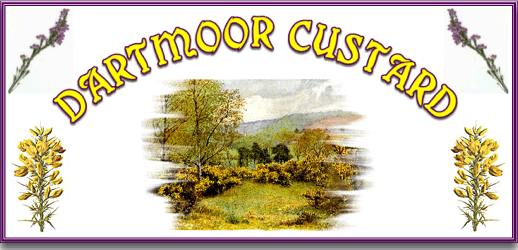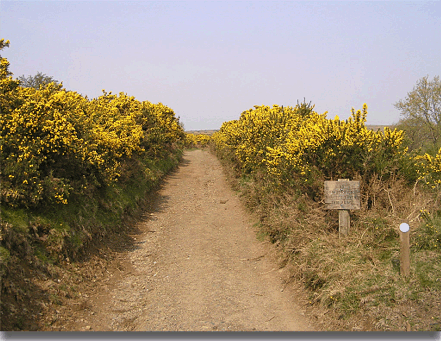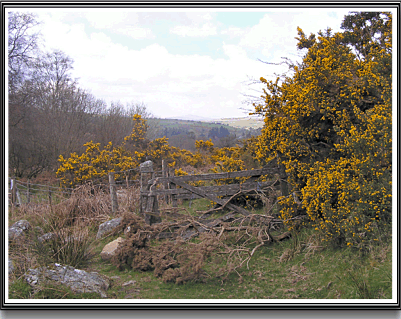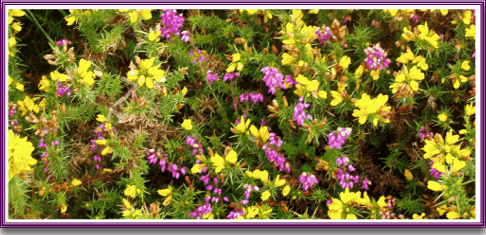
Somewhere, everyday you can see the ‘Dartmoor Custard’, it could be on the commons, up a small valley or by a wood;
“For second course, last night, a custard came
To th’board, so hot, as none co’d touch the
same;
Furze, three or four times with his cheeks did
blow
Upon the custard, and thus cooled so:
It seemed by this time to admit the touch;
But none co’d eat it, ’cause it stink so much.”
Robert Herrick
It is also known as Ulex europaeus, Whin, Fuzz, Furze or Gorse. In the above extract from Herrick’s poem he is bemoaning the scent of the Gorse which people either like or dislike. The beauty of the moorland heathers is renown with their mauve and purple hues, but to see them at their best you need to have the contrasting yellow gorse. The moorland ‘furze’ is widespread and for most of the year some of it will be in bloom. There is an old saying which goes:
“Furze is only out of bloom
When kissing’s out of tune.“
Which means ‘kissing’ occurs somewhere everyday as does the gorse blossom. Furze was adopted by Dartmoor sweethearts as a symbol of constancy in the hope that their loved remained as steadfast.

It was considered unlucky for a younger sister to get married before any older sibling, but if this should happen a ceremony known as ‘Dancing the Furze Faggot’ was held to cancel out any impending bad luck. After the younger sisters wedding a small faggot of furze was placed over the threshold of the family home and when after the wedding the elder, unmarried sister returned to the house she had to step over the furze faggot. This symbolically cancelled out any misfortune and would ensure that she too would marry.
It was always regarded it be extremely unlucky to bring furze into the house during the month of May because it would end up with a death in the household. It may be asked, why would anybody want to bring furze into the house during May? The answer is that furze wood was often used as a free and convenient fuel source.
At Christmas the poorer families would substitute furze in the form of a ‘kissing bush’ for mistletoe. A kissing bush was made by taking a small gorse bush and dipping it in water and then sprinkling it with flour to get a snow effect. This would then be put in a pot covered with silver paper and holly berries stuck on the furze thorns. People would then ‘kiss’ next to the kissing bush as opposed to under the mistletoe.

Furze has always come under the common rights of Dartmoor in so much as the commoners had the right to gather it for fuel. ‘Blacksticks’ were often collected after the gorse had been swaled (annual burning of gorse and bracken to allow regrowth) and was the charred wood left after the fire had died down. Collecting blacksticks was usually a chore the children of the house were given, they would tied them in bundles or faggots and take them back for burning fuel. On Dartmoor many houses had hearths with a stone ‘furze oven’ built into one of the sides. These would be heated with furze faggots or blacksticks and then the ashes would be scraped out and bread, cakes or pasties baked behind the heavy oven door. Other uses for gorse was making wine and yellow dye from the flowers and walking sticks from the gnarled branches.
There are numerous place and field names on Dartmoor with the element ‘furze’ denoting the presence of gorse. Amongst which are; Furze Hill, Furze Acres, Furze Park, Furzeland Down, Furzeleigh Mill and there is even a rock-climb on Heltor called ‘furze’. In contrast there are very few names with the element ‘gorse’ amongst which are Gorse Pool and Gorselands. The Old English name for furze or gorse was ceacge and this can be found as a descriptive element in the place-name of the small moorland town of Chagford, the derivative of which means Gorse Ford.
Moormen always knew that the furze plant was rich in nutrients and so it was common practice to cut or bruise the furze in order for the cattle to eat throughout the winter and early spring. The ponies will always give the furze a good ‘shoeing’ before eating it presumably to soften it. The other benefit of furze is that during times of heavy snow there is usually a patch sticking through which provides animals with something to browse.
There is nothing nicer than on a hot day walking across a Dartmoor common and feeling the warmth on your back , seeing a golden carpet of gorse and hearing the popping and cracking of the furze pods – you really know summer has arrived.

Furze and Heather – Custard and Jam
It is amazing the shape of a furze bush can take in a moor mist, on many occasions I have mistaken them for people and animals. The big bushes can provide a prickly refuge from a Dartmoor storm and it is amazing how dry the heart of a furze can be.
 Legendary Dartmoor The many aspects past and present of Dartmoor
Legendary Dartmoor The many aspects past and present of Dartmoor
